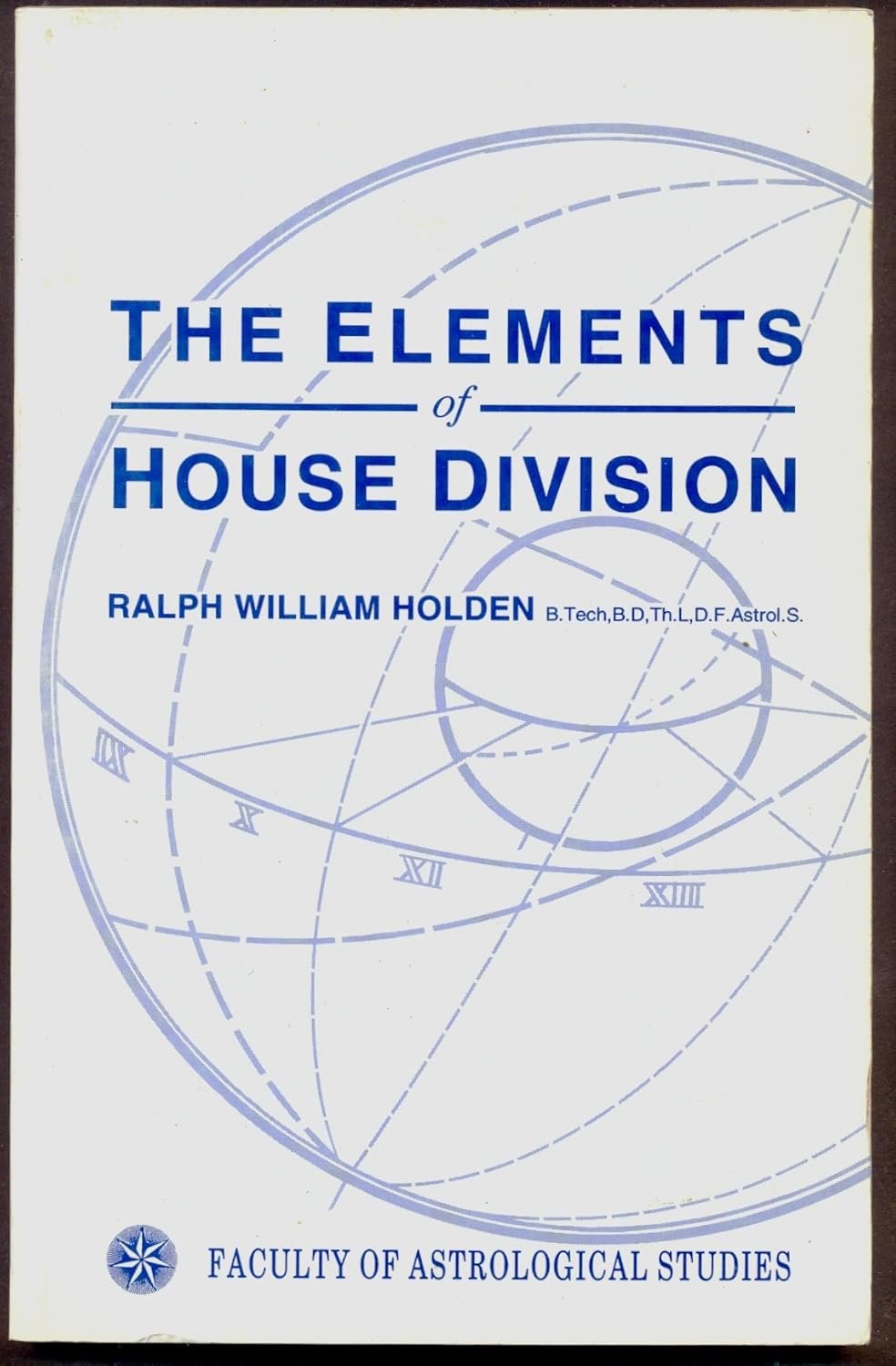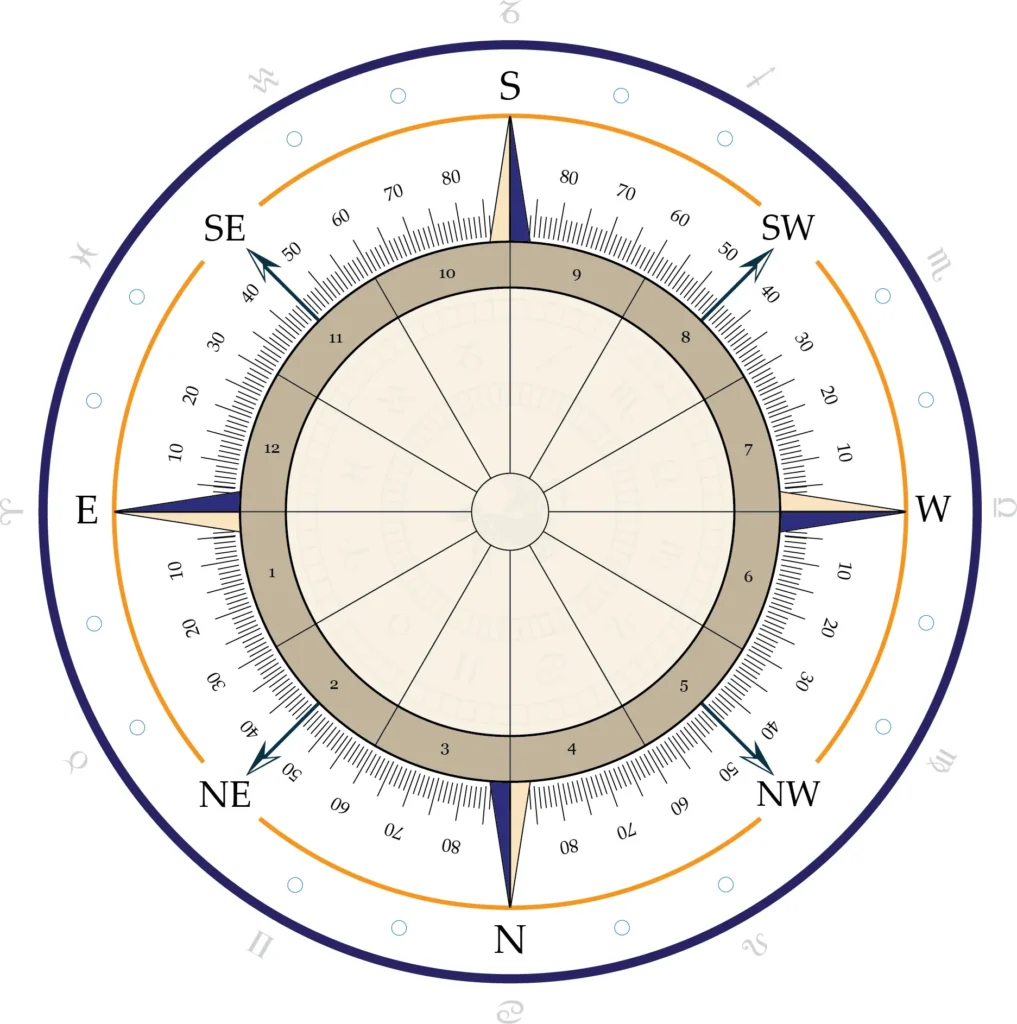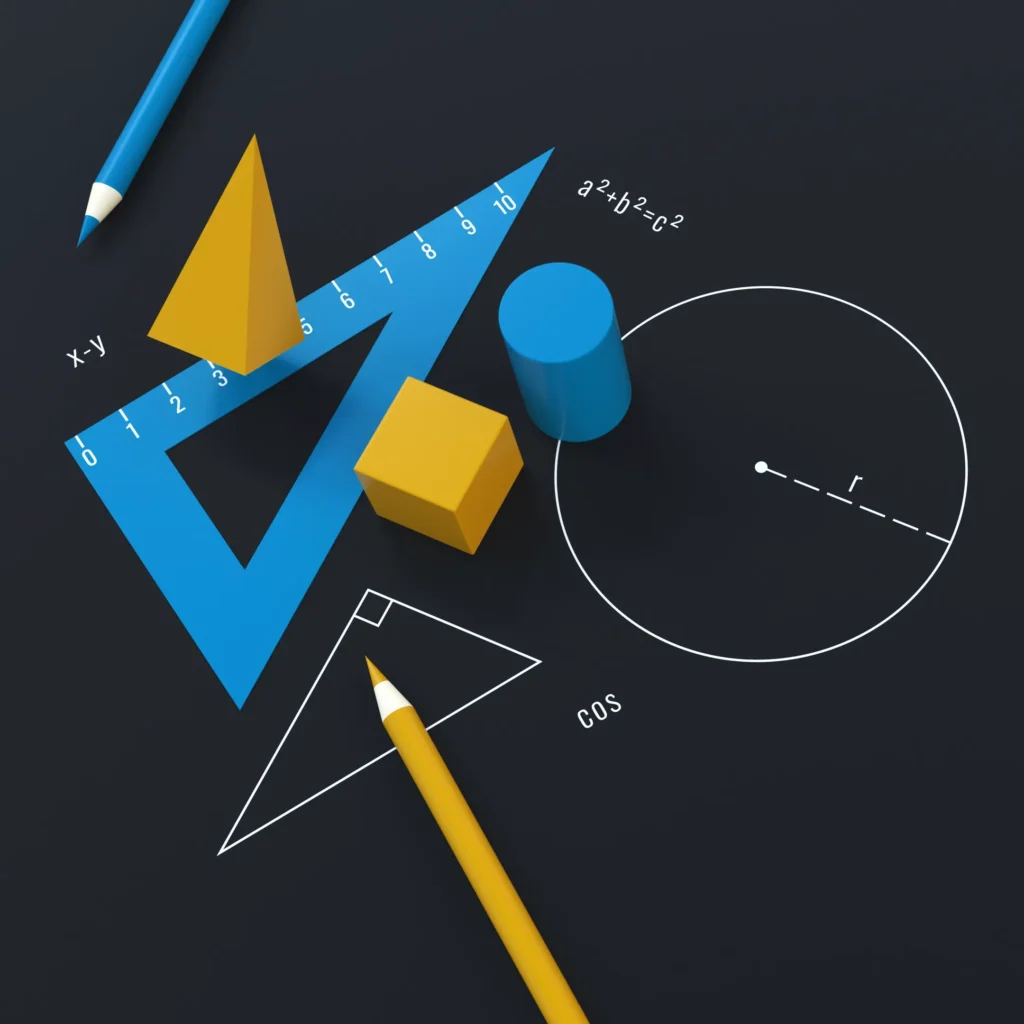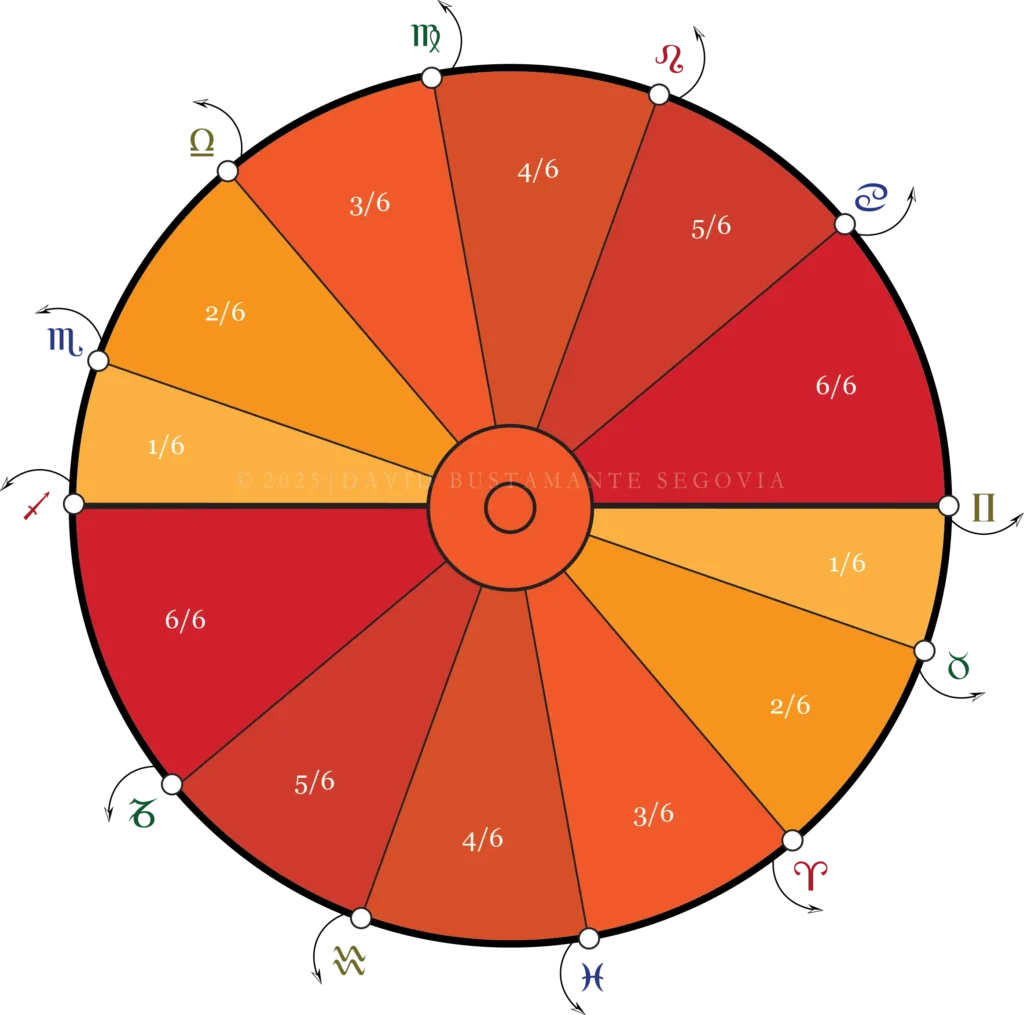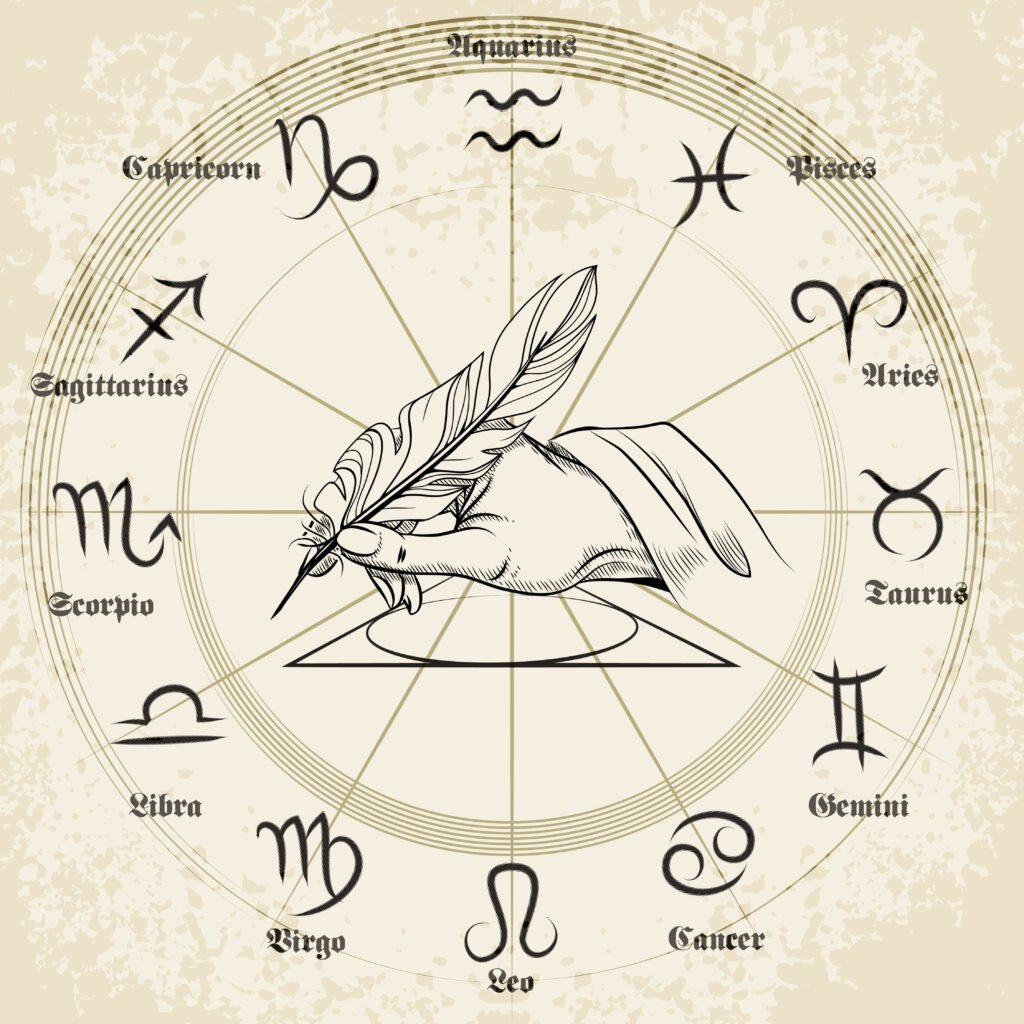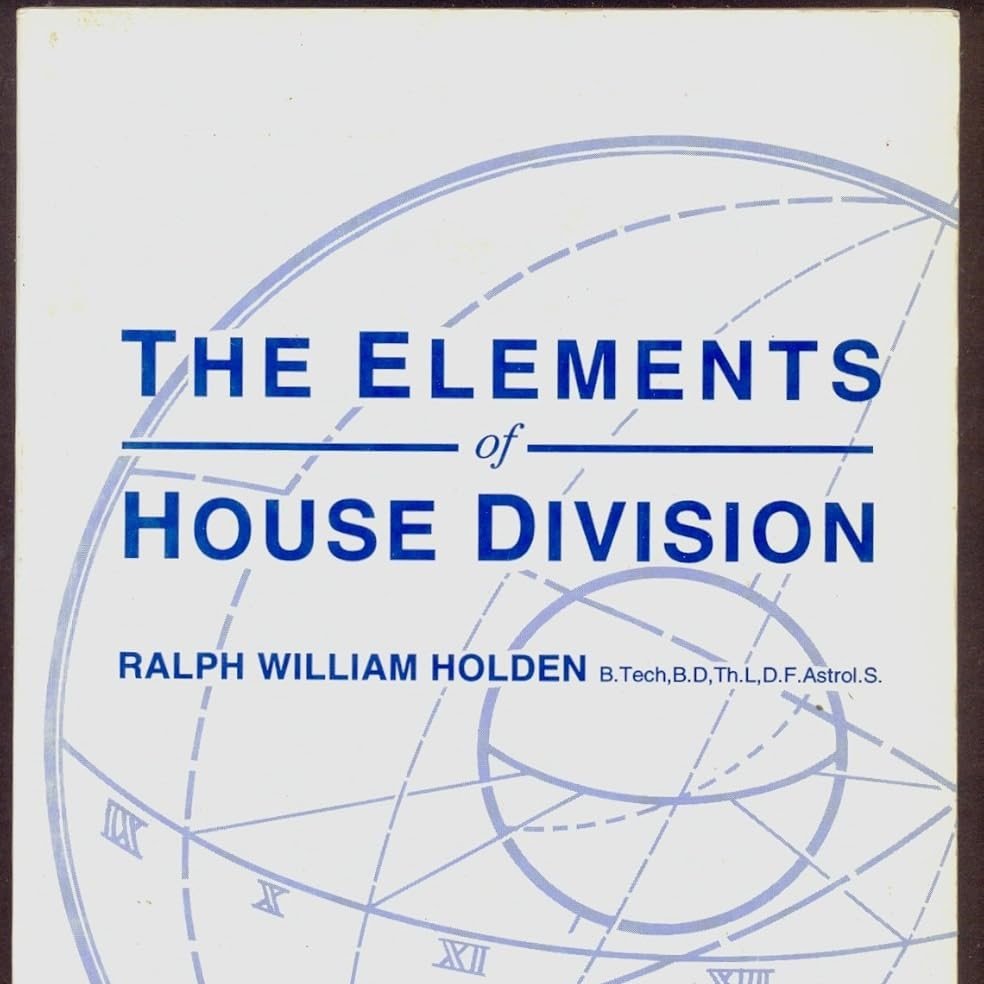
Ralph W. Holden’s Top 7 Takes on House Division and Astrology
Bright astrological theorist Ralph William Holden, in his work The Elements of House Division (1977, repr. 2023. Raven. Boulder, Colorado), maintained the following. You will find, immediately at the end of Holden’s paragraphs, our footnotes (comments) to his reflections and/or assertions in [light gray brackets]. Should you have liked the content, please share.
NO. 1 | On occupied or unoccupied houses (p. 30):
“The axial rotation of the Earth simply causes a displacement of the whole planetary map with respect to the horizon. This in turn naturally has the effects of causing the planets to fall within different houses of the horoscope, and since each house relates to a particular sphere of life or mundane activity, then planets falling within these houses will cause that particular house to assume a greater importance in the life than one which contains no planetary tenant.” [1]
[1] Although activity will always continue to take place at any region of the chart despite being — planetarily — unoccupied, were it occupied by planets it would become all the more active, busy, and/or relevant to the individual.
NO. 2 | The metaphor of the birth map and why houses (astrographic plane different from that of the ecliptic or Zodiac) are particularly relevant to accurate or otherwise responsible interpretation (pp. 30-31):
“In a sense they may be imagined as resembling the common lighting-effect produced by revolving a multi-coloured glass about a central light. The effect upon an observer is that he is bathed in a different colour at each instant (colour which is at that time ‘individual’ to himself) yet the nature and brightness of the source always being unchanged. In a similar way, the birth chart ‘stops’ the Earth’s rotation at a particular moment and the houses (related as they are to the actual position of the Earth in space) may be thought of as our multi-coloured glass ‘frozen’ at one instance of time, enabling us to examine the particular way in which the central ‘light’ is going to become evident in a particular life. The ‘light’, of course, being the planetary positions in this case and representative of the basic personality forces within the life: the houses, the spheres of experience in which this personality will especially express itself. Thus, without some kind of house structure, the ability of the astrologer to speak in truly individual terms is severely limited, as the means for making meaningful distinctions between the life development of individuals born at similar date (or at the same time in different places) is greatly restricted.” [2]
[2] In an as of yet English-published paper entitled «On Whole–Sign Houses’ Incompatibility with Human Diversity, and Quadrant Houses’ Compatibility, following Morin’s Rules of Astrological Delineation, and the Implications of this» (2023) we demonstrate the truth in these particular assertions by Holden. Let us say, for the time being, that a whole-sign chart — excluding the ASC and the MC degrees — remains exactly the same for all born during a full two-hour period, which may be considered to be simply nonsensical if we were to attribute the discipline or said “house” system any explanatory power whatsoever of the human being. As Holden rightfully states in the following paragraphs: the lack of anything in the chart changing sufficiently rapid enough to establish an enough number of astrographical distinctions between all born within a two-hour period constitutes the fundamental reason for which a whole sign chart cannot have any individual explanatory power.
NO. 3 | On prescinding from the employment of houses and the arguments in this regard (pp. 34-37):
“Traditional astrology bears no onus to prove the value and reliability of the concept of house division, since the method already carries close to 2,000 years of experience and approval. Rather the astrologer has the right to expect convincing statistical evidence to the contrary from those who would wish to abandon the concept of houses. […] Since this appears not to have been done, the use of houses must still therefore be considered to be a viable astrological concept […]”
“By rejecting the use of house division, Kepler, Witte, and Ebertin removed from their charts one of the major tools of individualising the horoscope. Without houses one simply cannot say as much of a truly individual nature about a person, and that which is said will apply to a greater number of people born on any given date. [3] One is left solely with the rising and culminating degrees as the only tools capable of distinguishing between the personality potentials of two persons born on the same date. Now, while these are important personal points, yet traditionally they are still tied in interpretation to the personality itself, rather than to the reaction of this character to the mundane events.”
“For this reason it has apparently followed that in those astrological systems in which house division has been rejected, and with it the possibility of deeply individual interpretation, other factors have been added in an attempt to increase the number of pieces of information available […] Kepler invented a number of new minor aspects […] Witte introduced midpoints […] Ebertin originally used close-orbed midpoints and later introduced the hypothetical ‘transpluto’. […] Thus while new factors are added to the interpretation of the chart, they do not change in their relationship to other parts of the birth map at a rate sufficiently quickly (except when made to an angle) to introduce truly personal factors. […] The only motion rapid enough to achieve this is the rotational motion of the Earth itself. [4] It is this which generates the ‘personal points’ […] and forms the framework for the interpretation of the sidereal birth-pattern into its mundane expression by means of the houses. It is in the houses, therefore, that we find offered the only satisfying hope of true individual […] delineation. [5] And since the prize is so great, it is surely worth the effort to examine the concept with a care and detail appropriate to the reward.”
[3] Idem.
[4] Because every four minutes of rotation generates a new unique chart that will not repeat itself before at least twenty thousand years have elapsed. At higher latitudes, it may take even less time for a new unique chart to be produced by the Earth’s rotation. In the paper previously mentioned (On Whole-Sign Houses Incompatibility and Quadrants’ Compatibility), we demonstrate that astrographical sequencing is just as possible as genetic sequencing (we provided an example; as in genetics, said sequence is quite extensive).
[5] A chart or an astrograph without or stripped from its houses is like a soul without a body, that is, a soul that has not incarnated.
NO. 4 | On astrology as a natural science (pp. 47-52):
“At this stage it will be of considerable advantage if we look briefly at astrological history. We will find this (as we would expect of any natural science) [6] to be the slow development of a series of basic principles which become the fundamental axioms of the discipline; and then the gradual refinement of these by a number of investigations in order to provide more accurate and reliable tools for the use of the astrologer.”
“[…] This being the case, one would therefore suspect, as in other scientific disciplines, [7] that the mor recent techniques would without question be the more accurate and authoritative. [8] For a variety of reasons, this simple approach would seem to be a false hope. No doubt this is due to the fact that astrology is unlike the normal physical sciences in a number of respects. For one thing, it deals with particular and not generalities. […] A person, being a unique creation, cannot as a self (as distinct from his associations with his species) be the subject of scientific analysis which requires as its prime axiom the repeatability of all experimentation.” [9]
“[…] Others naturally shy away from such a gross mechanistic approach and may seek to explain the matter along the lines of alteration of genetic structures through solar and cosmic radiation. […] being an empirical science based upon observations taken over many thousands of years, all that we are able to say is that if one set of conditions is seen to exist (the place and relationship of the planets) then we may predict that another set of conditions will exist at the same time (the nature of the personality of a child born at that moment). […] However […] no theory for this concurrence has been developed, such that from the theoretical basis alone we have been able to predict the occurrence of other, events which up to the present have passed unnoticed, have been unconnected with astrology, or have presented unresolved physical mysteries. […] Most astrological ‘theory’ has either been at variance with accepted laws of the physical universe, or when not has been unable satisfactorily to explain all the ramifications of astrology itself.”
“Leaves are green; the sky is blue; the night is dark; and the planets have certain meanings in the varied signs of the zodiac. These are not things discovered by theoretical calculations, but by empirical observations.”
[6] With said comparison he would seem to consider astrology to be a natural science.
[7] Idem.
[8] Although Holden does not incur either fallacy described in this footnote, it is worth mentioning that to defend the validity of any subject on the basis of either its modernity or antiquity constitutes either an ad novitatem or an ad antiquitatem fallacy, respectively. Non are valid arguments, for neither allude to a merit other than longevity or novelty, which is not a merit, but a mere condition of existence.
[9] Both primary directions (Ptolemy, 2nd century) and proluna (Boris Cristoff, 1969) are two timing techniques with a tremendous amount of potential concerning the “repeatability” of the matter at hand, especially in the second case. This technique states that all houses in any Placidus measured chart is comprised of 7 years of life, even though in each case less or more degrees will represent a full year within said house (depending on the latitude of the birth, a full year within a certain house may be comprised of four or less or more zodiacal degrees). Because the houses are related to certain stages of human development, we can identify the “plot” or “matters” most common to be experienced by any individual on Earth as soon as they reach the ages represented by the houses, just as much as we can establish certain commonalities among, say, octogenarians or teenagers (despite each having specific experiences as a teenager or an octogenarian, which would appear to be reflected by, among other variables, the arrangement of the house in question, that is, the signs governing it and the aspects and/or planets it hosts).
NO. 5 | On the Placidus measurement of the houses versus the topocentric or Polich-Page measurement:
(pp. 133-135)
However, when one turns to the Placidean system the matter is somewhat more complicated. Here we are not dividing a statis sphere, but our cusps are the result of the motion of a point upon the ecliptic. In fact, what is happening is that we have to imagine the whole plane of the horizon to be ‘tied’ to [different degrees that are] rising [simultaneously], [10] being carried through the space of the celestial sphere, and [their] position[s] at regular intervals marking the house boundaries. This, therefore, provides us with a means of determining the poles of these Placidean houses from a table of Ascendants in the following manner. […] The plane of the horizon does not make a simple rotation on an axis passing through the north and south poles of the original horizon except for a place located at the equator. Rather it describes a kind of skew motion which causes a displacement of the poles of the houses XI/III and XII/II. This results in a rather more complex formula being required if we wish to calculate the Placidean poles directly from the geographic location of the birthplace than was necessary for either Campanus or Regiomontanus. In this case the required formulae are as follows. […] The complexity of the Placidean formula results from the difficult motion of the ‘time motion’ of the Ascendant plane through the sphere. However, to an observer at the birthplace there is no such complexity in the way that the space of the heavens is seen. The authors of the topocentric system therefore have combined the division of the arcs of ascension of the ecliptical point as the basis of house division (as did Placidus) but have located the poles of the houses simply with respect to the geographic latitude of the birthplace. […] the authors [of topocentric houses] say ‘In this way the Topocentric System of Houses contains the joint solution of the two premises held by the two most important astrological schools of thought which exact one, the trisection of time (Placidus) and the other, the trisection of space (Campanus)’. The formulae for the poles in the topocentric system are […] In practise, the value of the cuspal points obtained by the use of these poles will be within 1º of those obtained by Placidus. […] Perhaps the […] important claim by Polich and Nelson-Page is that the topocentric system is not derived by theoretical considerations, but by empirical ones only.”
(pp. 177-178)
“The recent Topocentric system seems to offer some small theoretical advantages over the older Placidean one and may therefore be preferred to it. However, the difficulty in obtaining tables at the present time makes it in practise less acceptable; and one would suspect that as nearly identical results are obtained from both methods, [11] one may as well settle for the widely known and widely used Placidus system. Thus, the choice here seems to lie between Placidus and Alcabitius. […]”
[10] At least on two occasions we were able to determine Holden’s slight error when describing the Placidus houses, as he would describe the Alcabitius calculation in their stead. Hence our brackets in the previous sentence, so as to correct what would become confusing for the reader expecting to find the description of the Placidus measurement, not that of Alcabitius. Holden originally wrote: “In fact, what is happening is that we have to imagine the whole plane of the horizon to be ‘tied’ to that degree of the ecliptic, which is rising […]”
[11] The topocentric measurement, if not identical to that of Placidus, may be considered to be redundant, for all the reasons presented by Holden. Michael Wackford, for his part, has pointed out even the fact that Polich and Page claims about their method are not entirely true. Although Michael wrote his articles on the Placidus houses and polar horoscopes for Correlation (AA), the reader will find these published online at Skyscript.
NO. 6 | On why the Koch measurement of the houses claimed much more than it could demonstrate (pp. 127-129):
“Tables for this system were first published in 1971 with rather surprising claims of originality and infallibility. The instructions claim that its author […] ‘has at long last succeeded in solving the astronomical problem of house division’. […] This sounds all extremely technical, but when we examine the celestial sphere, these apparent complexities will become self-evident. […] the system is only a variation upon that of Alcabitius. […] It will be seen that the zodiacal longitude of the point XII and XI can be obtained simply by adding the increments of time to that of the time when the MC is at the Ascendent, [12] and then reading from the tables the degree rising at the time so found. […] It will be seen that the values of the cusps may be obtained with extreme simplicity from a table of Ascendants and that separate tables of the Koch houses are [therefore] quite unnecessary. […] whether it has the superlative theoretical advantage claimed for it must be open to grave doubt, and it is possible that it is the least acceptable of all the time systems. Certainly it is quite misleading to state that it ‘has long last succeeded in solving the astronomical problems of house division’.”
[12] In paper «Time Dilation according to Tropical Astrology and Why the Placidus Measurement of the Astrographic Regions is Compatible with Relativity Theory» (26 September 2024), we describe in detail the mechanism of action summarised here by Holden concerning the Koch measurement, as well as those of Alcabitius and Placidus.
NO. 7 | On Holden’s preference and why Alcabitius constitutes a convenient abbreviation of Placidus for higher latitudes in lack of softwares (p. 178):
“My own preference, and it is hard to see how it can be judged otherwise, [13] is for Placidus. Since the essence of the time method is that of rotation of a point (in both of these the rising degree is that point) it would seem more reasonable actually to trace this point [14] as it moves in oblique ascension (and to find the actual time at which it becomes the cusp) than to imagine the time arc between the ascendent and the Midheaven to be a kind of ‘static’ arc in space, and to trisect this in a geometric manner as if this same degree could occupy the positions of both ascendant and Midheaven simultaneously. That is, Placidus is more ‘dynamic’ than is that of Alcabitius. This is perhaps a little unfortunate, as the older system is extremely simple and straightforward in use. [15] Perhaps one could make out a case for it, on purely practical grounds, in charts using time methods of domification in higher latitudes.”
[13] Holden here seems to consider obvious the advantage of the Placidus measurement of the houses, that is, what one may portray as its natural versatility, which he would call or regard, insistently so, as “dynamic”.
[14] Holden seems to describe, again, Alcabitius instead of Placidus because, unlike Alcabitius, it would trace all possible ascending degrees, that is, duly recognise or otherwise record the ascensional times of all degrees contained between the ASC and the MC, as to distinguish the exact temporal length of each house (Placidus houses do not measure the same time, as many believe).
[15] In a paper on relativity by tropical astrology and the Placidus measurement of the houses we explain why Alcabitius constitutes a brilliant abbreviation of the Placidus formula and that, were it not for the existence of software technology, it would be nothing if not wise to rely on said measurement always (unless dealing with the first or the last portion of a sign at latitudes far away from the equator).
